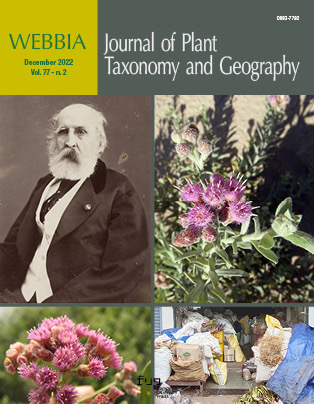Lychnophora pseudovillosissima (Asteraceae: Vernonieae: Lychnophorinae), a new species restricted to Minas Gerais, Brazil
Published 2022-12-15
Keywords
- campo rupestre,
- Compositae,
- Lychnophorinae,
- Neotropical Flora,
- Taxonomy
- Espinhaço Range ...More
How to Cite
Funding data
-
Coordenação de Aperfeiçoamento de Pessoal de Nível Superior
Grant numbers 001
Abstract
Lychnophora pseudovillosissima, a new species from the State of Minas Gerais, Brazil, is here described and illustrated. The new species is unique because of the combination of petiolate linear leaves with revolute margins, reticulodromous venation, and 3–5 florets per capitulum. The new species is compared to a morphologically similar species, L. villosissima, resembling in habit, leaves, venation, and number of florets per capitulum, but differing by the shape and size of the leaf and petiole. Both species may occur sympatrically, but are uniform in their morphology with diagnostic features that differentiate them. Accompanying the description and the illustration, we provide a photographic plate, a first assessment of the species’ conservation status, as well as comments on the geographic distribution, ecology, and identification of the new species.
References
BFG - THE BRAZIL FLORA GROUP. 2015. Growing knowledge: An overview of seed plant diversity in Brazil. Rodriguésia. 66: 1085 – 1113.
Cavallari MM, Forzza RC, Veasey EA, Zucchi MI, Oliveira GCX. 2006. Genetic variation in three endangered species of Encholirium (Bromeliaceae) from Cadeia do Espinhaço, Brazil, setected using RAPD markers. Biodiversity Conservation. 15: 4357 – 4373.
Colli-Silva M, Vasconcelos TN, Pirani JR. 2019. Outstanding plant endemism levels strongly support the recognition of campo rupestre provinces in mountaintops of eastern South America. Journal of Biogeography. 46(8): 1723 – 1733.
Gardner G. 1846. Contributions towards a Flora of Brazil, being the distinctive characters of some new species of Compositae, belonging to the tribe Vernoniaceae. The London Journal of Botany. 5: 209 – 242.
Gomes FMB, Loeuille B. 2021. Three New Species of Lychnopcephalus (Asteraceae: Vernonieae) from the Serra do Cipó, Minas Gerais, Brazil. Systematic Botany 46(2): 476-485.
Harris JG, Harris MW. 2001. Plant identification terminology: an illustrated glossary. 2nd Edition. Spring Lake, USA, Spring Lake Publishing.
Hickey LJ. 1973. Classification of the architecture of dicotyledonous leaves. American Journal of Botany. 60(1): 17 – 33.
IPNI. 2021. International Plant Names Index. Published on the Internet http://www.ipni.org, The Royal Botanic Gardens, Kew, Harvard University Herbaria & Libraries and Australian National Botanic Gardens. [accessed: 2022 May 24].
IUCN. 2012. IUCN Red list Categories and Criteria: Version 3.1, 2nd Edition. IUCN, Gland, Switzerland and Cambridge, UK. Available at https://portals.iucn.org/library/node/10315 [accessed: 2020 August 4].
Keles LC, Melo I, Aguiar GP, Wakabayashi KAL, Carvalho CE., Cunha, W. R., Crotti, A. E. M., Lopes, J. L. C. & Lopes, N. P. (2010) Lychnophora (Asteraceae): A survey of its chemical constituents and biological activities. Quimica Nova 33(10): 2245 – 2260.
Konno, T. U. P., Rapini, A., Goyder, D. J. & Chase, MW. 2006. The new genus Minaria (Asclepiadoideae, Apocynaceae). Taxon 55(2): 421 – 430.
Loeuille B., Semir J., Lohmann L. G., Pirani J. R. (2015) A phylogenetic analysis of Lychnophorinae (Asteraceae: Vernonieae) based on molecular and morphological data. Systematic Botany 40(1): 299 – 315.
Loueille B, Semir J, Pirani JR. 2019. A synopsis of Lychnophorinae (Asteraceae: Vernoniae). Phytotaxa. 398(1): 1–139.
Marques D, Via do Pico GM, Nakajima J. 2018. A New Species of Lychnophora Mart. (Vernonieae: Asteraceae) from Minas Gerais, State, Brazil. Systematic Botany. 43 (4): 1051 – 1058.
Martius CFP von .1822. Novum plantarum genus Lychnophora. Denkschriften der Koniglich-Baierischen Botanischen Gesellschaft in Regensburg 2: 148–159, tab. 4–10.
Miola D, Ramos, VDV, Silveira FAO. 2020. A brief history of research in campo rupestre: identifying research priorities and revisiting the geographic distribution of an ancient, widespread Neotropical biome. Biological Journal of the Linnean Society. 133(2): 1-17.
Pougy N, Verdi M, Martins E, Loyola R, Martinelli G. 2015. Áreas Prioritárias Para a Conservação da Serra do Espinhaço Meridional. In: Pougy N, Verdi M, Martins E, Loyola R, Martinelli G. (eds) Plano de Ação nacional para a Conservação da Flora Ameaçada de Extinção da Serra do Espinhaço Meridional. Rio de Janeiro, Instituto de Pesquisas Jardim Botânico do Rio de Janeiro.
QGIS Development Team. 2018. QGIS Geographic Information System. Version 3.0.1. Open Source Geospatial Foundation Project.
Reflora-Plantas do Brasil: Resgate histórico e herbário virtual para o conhecimento e conservação da flora brasileira. Available at: http://reflora.jbrj.gov.br/ [Accessed June 3, 2022].
Roque N, Keil D, Susanna A. 2009. Illustrated Glossary of Compositae - Appendix A. In: Funk V.A., Susanna A., Stuessy T., Bayer R.J. (eds) Systematics, Evolution, and Biogeography of Compositae: 781–806. Vienna, IAPT.
Semir J. 1991. Revisão taxonômica de Lychnophora Mart. (Vernonieae: Compositae) [Ph. D thesis]. Campinas (SP): Universidade Estadual de Campinas.
Semir, J, Rezende AR, Monge M, Lopes NP. 2011. As Arnicas endêmicas das Serras do Brasil: uma visão sobre a biologia e a química das espécies de Lychnophora (Asteraceae). UFOP, Ouro Preto, 211 pp.
Semir J, Loeuille B, Monge M. 2014. The Lychnophora granmogolensis (Asteraceae–Vernonieae) Species Complex: Two New Species and Comments on the Identity of Lychnophora granmogolensis. Systematic Botany 39: 988–996.
Silveira FAO, Negreiros D, Barbosa NPU, Buisson E, Carmo FF, Cartensen DW, Conceição AA, Cornelissen TG, Echternacht L, Fernandes GW, Garcia QS, Guerra TJ, Jacobi CM, Lemos-Filho JP, Stradic SL, Morellato LPC, Neves FS, Oliveira RS, Schaefer CE, Viana PL, Lambers H. 2016. Ecology and evolution of plant diversity in the endangered campo rupestre: a neglected conservation priority. Plant and Soil. 403: 129–152.
SpeciesLink. 2022. Downloadable from http://www.splink.org. br/ [accessed June 3 2022].
The Plant List. 2013. Version 1.1. Published on the Internet; http://www.theplantlist.org/ [accessed 2022 June 2].
Thiers B, continuously update. Index Herbariorum: a global directory of public herbaria and associated staff. New York Botanical Garden’s Virtual Herbarium. [accessed 2022 June 2].


